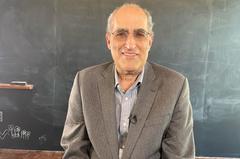Edward Witten will receive the 2023 Hamburg Prize for Theoretical Physics. Photo: OFC LLC.
The US physicist Edward Witten will be awarded the Hamburg Prize for Theoretical Physics 2023. The professor emeritus at the Institute for Advanced Study in Princeton/USA is honored for his pioneering contributions to a unified mathematical description of fundamental forces of nature. With his outstanding research on string and quantum theory, Edward Witten has had a lasting impact on the understanding of space, time, matter and the structure of the cosmos. The impetus of his work reaches far into other disciplines, especially mathematics.
The Hamburg Prize for Theoretical Physics is one of the most highly endowed science prizes for physics in Germany and is awarded by the Joachim Herz Foundation together with the Wolfgang Pauli Centre of DESY and the University of Hamburg, the German Electron Synchrotron DESY and the two Clusters of Excellence "CUI: Advanced Imaging of Matter" and "Quantum Universe" at the University of Hamburg. The award ceremony will take place on November 8 in Hamburg.
Edward Witten is one of the most renowned and frequently cited theoretical physicists of our time. For decades, he has provided important impulses for the development of a grand unified theory of physics that describes all the forces and building blocks of the universe. String theory has been considered a promising candidate for this since the 1970s because it builds a bridge between two established pillars of physics: Quantum Theory, which determines the interplay of subatomic particles, and Albert Einstein's General Relativity, which describes gravity as a consequence of the curvature of space and predicts the evolution of stars, galaxies and black holes.
Bridging the gap between two pillars of physics
According to string theory, quantum and gravitational theory can be united under the umbrella of a new mathematical formalism. Elementary particles are considered as tiny line-shaped objects, the strings. Quarks, electrons, and all other known elementary particles are thus nothing more than different vibrational patterns of the same particle. In the 1980s, with the significant participation of Edward Witten, it crystallized that this paradigm shift would allow all four fundamental forces of nature - gravitation, electromagnetism, weak interaction, strong nuclear force - to be described by a unified quantum mechanical field theory.
A puzzle remained, however, that five possible versions of string theory were known at that time. If one of them describes our universe, who lives in the other four worlds? Drawing on the work of numerous colleagues, Witten presented a solution to this problem at a conference in California in 1995: If quantum mechanical effects are fully taken into account, the differences between the five string theories melt away. They all turn out to be limiting cases of a more fundamental theory, called M-theory. It states that strings are manifestations of vibrating membranes and is considered a candidate for the grand unification of the laws of nature.
"In Edward Witten, we are honoring this year a scientist whose work has been seminal in the development of string theory and quantum field theory, and has provided important impetus far beyond. We would like to honor this achievement and his work at the interface between physics and mathematics with the Hamburg Prize for Theoretical Physics," says Sabine Kunst, Chairman of the Board of the Joachim Herz Foundation.
Impetus for cutting-edge research in Hamburg
The Hamburg Prize for Theoretical Physics has been awarded to internationally renowned researchers since 2010. It is one of the most highly endowed science prizes for physics in Germany. The prize money is 137,036 euros, an allusion to Sommerfeld's fine structure constant, which plays an important role in theoretical physics.
The physics prize for Edward Witten is associated with a research stay in Hamburg. "Edward Witten's pioneering work is closely linked to Science City Hamburg Bahrenfeld, for example, through the research foci in the Cluster of Excellence "Quantum Universe" and especially also at the Hamburg Center for Mathematical Physics, which DESY and the University of Hamburg have jointly established since 2004. We are therefore looking forward to the exchange with this luminary with great excitement and anticipation," says Volker Schomerus, senior scientist at DESY and spokesman of the Wolfgang Pauli Centre.
Outstanding achievements at the interface between physics and mathematics
In the course of his career, Edward Witten has not only made a name for himself as a leading string theorist. He also gave important impulses in other areas of mathematical physics, from quantum theory to condensed matter physics, sometimes with applications in gravitational theory and astronomy. His work on topological quantum field theory, for example, opened new horizons for mathematicians in the late 1980s in understanding the geometric structures and regularities of knots. Edward Witten's extraordinary ability to translate abstract concepts such as Richard Feynman's famous path integrals from physics to mathematics makes him an outstanding figure at the interface of the two disciplines. Edward Witten has received many awards, including being the first physicist ever to receive the Fields Medal in 1990. It is considered the highest honor for mathematicians.
About Edward Witten
Edward Witten was born in Baltimore, Maryland, in 1951. After receiving a bachelor's degree from Brandeis University in Massachusetts, he studied applied mathematics and physics at Princeton University/New Jersey. The supervisor for his PhD on quantum gauge theories was David Gross, who received the 2004 Nobel Prize in Physics for his contribution to the theory of the strong interaction. After a postdoctoral position at Harvard University, Edward Witten became a professor at Princeton University in 1980 and a professor of mathematical physics at the Institute for Advanced Study at Princeton in 1987.
Further information:
In an interview, the Joachim Herz Foundation introduces the scientist and human being Edward Witten. He provides insight into his highly complex scientific work and reveals what the letter M in M-theory is all about: www.joachim-herz-stiftung.de/storys/edward-witten








